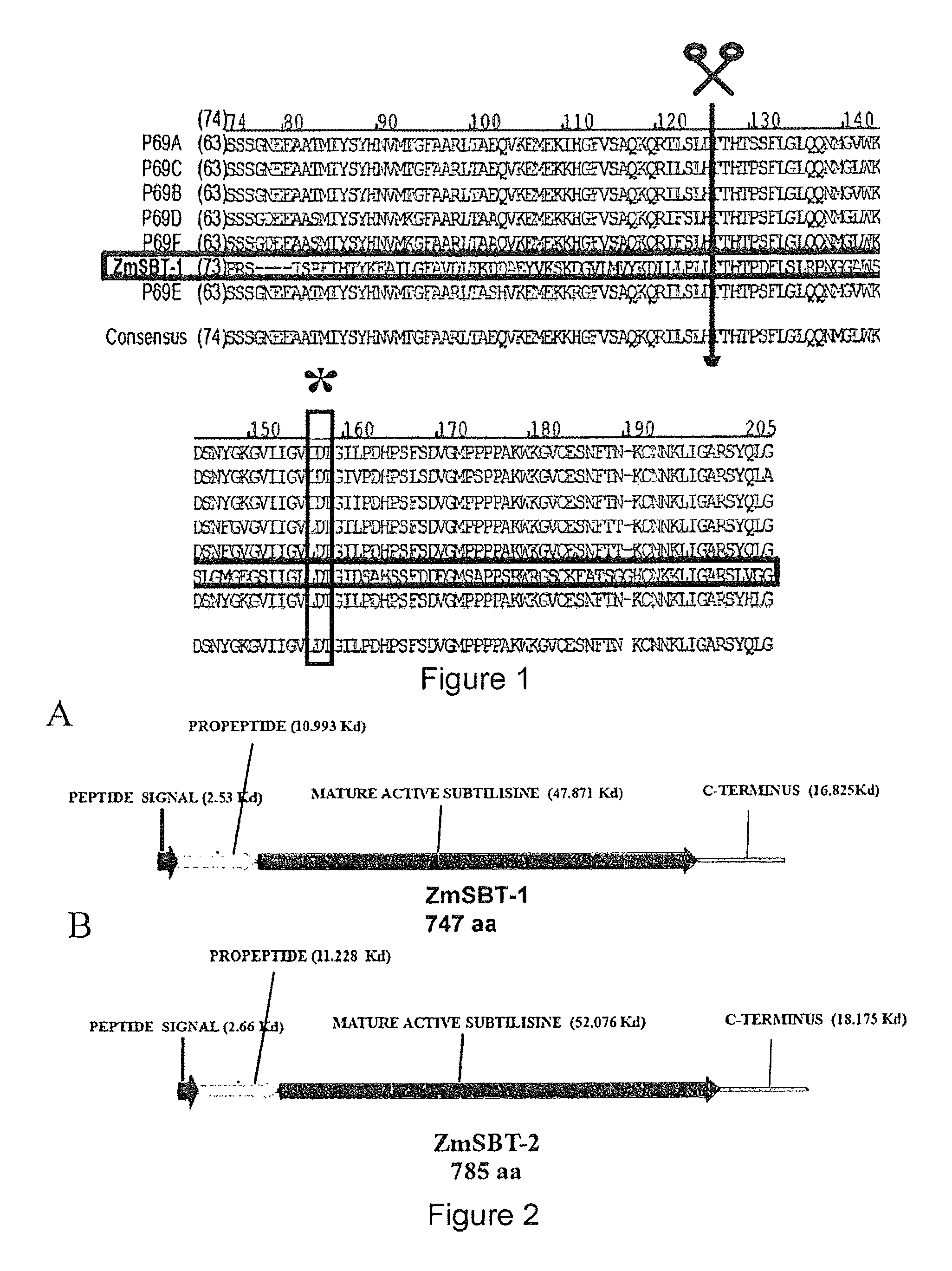Pedicel specific promoter
a promoter and pedicel technology, applied in the field can solve the problem of limited understanding of the function of subtilase in plants, and achieve the effect of improving the efficiency reducing the number of pedicel specific promoters
- Summary
- Abstract
- Description
- Claims
- Application Information
AI Technical Summary
Benefits of technology
Problems solved by technology
Method used
Image
Examples
example 1
Identification of an Endosperm Specific Subtilisin-Like Protease Gene
[0142]In order to identify genes differentially expressed during maize kernel development, an expression database was built from 6000 transcripts randomly selected from a 10 days after pollination (DAP) endosperm cDNA library, using a differential screening method. Clones 14-15A and 24-27 showed moderate hybridization to a subtracted probe specific for the top half of the kernel, but no signal with any other probe in the set. These clones carry overlapping region of the same gene (850 by and 650 by long insert respectively) encoding a protein with significant similarity to a serine protease of the subtilisin family. A third clone, 26-42 (1000 by long insert), that showed no signal with any probe, corresponded to another overlapping region of this subtilisin-like protease gene. Overlapping clone sequence was compared with public database and it was truncated in 1200 by with regard to a full length cDNA. RACE experim...
example 2
ZmSBT-2, a Second Subtilisin-Like Protease Gene Exclusively Expressed in Maize Kernel
[0150]In order to identify this second gene expressed in plazentochalaza region, a search in our expression database was carried out. A cDNA clone encoding a protein related to ZmSBT-1 was found. This cDNA showed moderate hybridization to a subtracted probe specific for the bottom half of the kernel, but no signal with any other probe in the set. The putative 2500 by full length cDNA was obtained by means of ESTs public databases. The encoded protein has a predicted molecular weight of 84 KDa and a total of 785 amino acids. The gene was therefore named ZmSBT-2 (Zea mays Subtilisin-2). The computer based comparison of amino acid sequence of the NH2 terminus indicated the existence of a pre-pro-sequence, consisting of a hydrophobic signal peptide at the extreme NH2terminus (24 amino acids, 2.66 kDa.), followed by a 101 amino acid pro-sequence (11.228 kDa) which is a typical feature of proteases of Sub...
example 3
A 3552 bp Promoter Sequence from ZmSBT-1 Directs the Expression of the Gus Reporter Gene in the Endosperm Aleurone Cell Layer
[0153]The ability of this promoter fragment to confer aleurone cell specific expression in transgenic maize was tested by maize transformation with the GUS reporter gene. Three independent transgenic lines (EUG 4A, EUG 10A y EUG 14A) were obtained and analyzed in detail. Plants containing the GUS gene were identified by PCR analysis. The transgenic lines were further analyzed by Southern blot using Sac I, an enzyme that does not cleave within the reporter gene. Probing Sac I digested DNA with the GUS coding sequence gave different patterns of hybridization for each transgenic line (a single copy and three copies integration in EUG 4A and EUG 10A, respectively), confirming their independent origin.
[0154]Histochemical staining of leaves, roots and adventitious roots for GUS did not give signals for any transgenic line analyzed (not shown). The transgenic plants ...
PUM
| Property | Measurement | Unit |
|---|---|---|
| Tm | aaaaa | aaaaa |
| Tm | aaaaa | aaaaa |
| temperature | aaaaa | aaaaa |
Abstract
Description
Claims
Application Information
 Login to View More
Login to View More - R&D
- Intellectual Property
- Life Sciences
- Materials
- Tech Scout
- Unparalleled Data Quality
- Higher Quality Content
- 60% Fewer Hallucinations
Browse by: Latest US Patents, China's latest patents, Technical Efficacy Thesaurus, Application Domain, Technology Topic, Popular Technical Reports.
© 2025 PatSnap. All rights reserved.Legal|Privacy policy|Modern Slavery Act Transparency Statement|Sitemap|About US| Contact US: help@patsnap.com



